Laser-Assisted Preparation of TiO2/Carbon/Ag Nanocomposite for Degradation of Organic Pollutants
Abstract
:1. Introduction
2. Materials and Methods
2.1. Materials and Equipment
2.2. Preparation of Carbon Powder
2.3. Preparation of TiO2/Carbon/Ag Nanocomposite
2.4. Investigation of the Dye Removal Efficiency of TiO2/C/Ag Nanocomposite
2.4.1. The Catalytic Reduction of Methylene Blue (MB)
2.4.2. The Catalytic Reduction of Congo Red (CR)
2.4.3. The Catalytic Reduction of 4-NP
3. Results
3.1. Characterization
3.2. The Ability of TiO2/C/Ag Nanocomposite in the Reduction of MB, CR, and 4-NP
| Catalyst | Concentration of 4-NP | Concentration of NaBH4 | Reduction Time | Ref. |
|---|---|---|---|---|
| Ag/N-RGO | 0.2 mM | 0.2 M | 400 s | [96] |
| Ag/MWCNTs–chitosan | 0.10 mM | 5 mM | 5 min | [97] |
| Calcinated TiO2/Ag core–shell | 5 mM | 0.02 M | 13 min | [98] |
| Ag/TiO2 | 15 mg/L | 0.02 M | 50 min | [99] |
| TiO2/C/Ag | 2.5 × 10−3 M | 250 mM | 2.30 min | This work |
3.3. Catalyst Recyclability
4. Conclusions
Author Contributions
Funding
Institutional Review Board Statement
Informed Consent Statement
Data Availability Statement
Conflicts of Interest
References
- Mashkoor, F.; Nasar, A. Magsorbents: Potential candidates in wastewater treatment technology-A review on the removal of methylene blue dye. J. Magn. Magn. Mater. 2020, 500, 166408. [Google Scholar] [CrossRef]
- Katheresan, V.; Kansedo, J.; Lau, S.Y. Efficiency of various recent wastewater dye removal methods: A review. J. Environ. Chem. Eng. 2018, 6, 4676–4697. [Google Scholar] [CrossRef]
- Su, C.X.-H.; Low, L.W.; Teng, T.T.; Wong, Y.S. Combination and hybridisation of treatments in dye wastewater treatment: A review. J. Environ. Chem. Eng. 2016, 4, 3618–3631. [Google Scholar] [CrossRef]
- Naseem, K.; Farooqi, Z.H.; Begum, R.; Irfan, A. Removal of Congo red dye from aqueous medium by its catalytic reduction using sodium borohydride in the presence of various inorganic nano-catalysts: A review. J. Clean. Prod. 2018, 187, 296–307. [Google Scholar] [CrossRef]
- Das, J.; Velusamy, P. Catalytic reduction of methylene blue using biogenic gold nanoparticles from Sesbania grandiflora L. J. Taiwan Inst. Chem. Eng. 2014, 45, 2280–2285. [Google Scholar] [CrossRef]
- Ahmad, A.; Mohd-Setapar, S.H.; Chuong, C.S.; Khatoon, A.; Wani, W.A.; Kumar, R.; Rafatullah, M. Recent advances in new generation dye removal technologies: Novel search for approaches to reprocess wastewater. RSC Adv. 2015, 5, 30801–30818. [Google Scholar] [CrossRef]
- Adesanmi, B.M.; Hung, Y.-T.; Paul, H.; Huhnke, C. Comparison of dye wastewater treatment methods: A review. GSC Adv. Res. Rev. 2022, 10, 126. [Google Scholar] [CrossRef]
- Anis, S.M.; Hashemi, S.H.; Nasri, A.; Sajjadi, M.; Eslamipanah, M.; Jaleh, B. Decorated ZrO2 by Au nanoparticles as a potential nanocatalyst for the reduction of organic dyes in water. Inorg. Chem. Commun. 2022, 141, 109489. [Google Scholar] [CrossRef]
- Jaleh, B.; Mousavi, S.S.; Sajjadi, M.; Eslamipanah, M.; Maryaki, M.J.; Orooji, Y.; Varma, R.S. Synthesis of bentonite/Ag nanocomposite by laser ablation in air and its application in remediation. Chemosphere 2023, 315, 137668. [Google Scholar] [CrossRef] [PubMed]
- Veisi, H.; Moradi, S.B.; Saljooqi, A.; Safarimehr, P. Silver nanoparticle-decorated on tannic acid-modified magnetite nanoparticles (Fe3O4@TA/Ag) for highly active catalytic reduction of 4-nitrophenol, Rhodamine B and Methylene blue. Mater. Sci. Eng. C 2019, 100, 445–452. [Google Scholar] [CrossRef]
- Sen, I.K.; Maity, K.; Islam, S.S. Green synthesis of gold nanoparticles using a glucan of an edible mushroom and study of catalytic activity. Carbohydr. Polym. 2013, 91, 518–528. [Google Scholar] [CrossRef]
- Dasog, M.; Hou, W.; Scott, R.W. Controlled growth and catalytic activity of gold monolayer protected clusters in presence of borohydride salts. Chem. Commun. 2011, 47, 8569–8571. [Google Scholar] [CrossRef]
- Qi, L.; Zhang, K.; Qin, W.; Hu, Y. Highly efficient flow-through catalytic reduction of methylene blue using silver nanoparticles functionalized cotton. Chem. Eng. J. 2020, 388, 124252. [Google Scholar] [CrossRef]
- Naushad, M.; Ahamad, T.; Khan, M.R. Remediation of wastewater containing 4-nitrophenol using ionic liquid stabilized nanoparticles: Synthesis, characterizations and applications. Chemosphere 2022, 303, 135173. [Google Scholar] [CrossRef] [PubMed]
- Lajevardi, A.; Yaraki, M.T.; Masjedi, A.; Nouri, A.; Sadr, M.H. Green synthesis of MOF@Ag nanocomposites for catalytic reduction of methylene blue. J. Mol. Liq. 2019, 276, 371–378. [Google Scholar] [CrossRef]
- Sana, S.S.; Haldhar, R.; Parameswaranpillai, J.; Chavali, M.; Kim, S.-C. Silver nanoparticles-based composite for dye removal: A comprehensive review. Clean. Mater. 2022, 6, 100161. [Google Scholar] [CrossRef]
- Jayapriya, M.; Arulmozhi, M. Beta vulgaris peel extract mediated synthesis of Ag/TiO2 nanocomposite: Characterization, evaluation of antibacterial and catalytic degradation of textile dyes-an electron relay effect. Inorg. Chem. Commun. 2021, 128, 108529. [Google Scholar] [CrossRef]
- Zhang, L.; Han, M.; Tan, O.K.; Tse, M.S.; Wang, Y.X.; Sze, C.C. Facile fabrication of Ag/C-TiO2 nanoparticles with enhanced visible light photocatalytic activity for disinfection of Escherichia coli and Enterococcus faecalis. J. Mater. Chem. B 2013, 1, 564–570. [Google Scholar] [CrossRef]
- Ng, H.M.; Leo, C.; Abdullah, A. Selective removal of dyes by molecular imprinted TiO2 nanoparticles in polysulfone ultrafiltration membrane. J. Environ. Chem. Eng. 2017, 5, 3991–3998. [Google Scholar]
- Rath, P.; Priyadarshini, B.; Behera, S.; Parhi, P.; Panda, S.; Sahoo, T. Adsorptive removal of Congo Red dye from aqueous solution using TiO2 nanoparticles: Kinetics, thermodynamics and isothermal insights. AIP Conf. Proc. 2019, 2115, 030115. [Google Scholar]
- Sathiyan, K.; Bar-Ziv, R.; Mendelson, O.; Zidki, T. Controllable synthesis of TiO2 nanoparticles and their photocatalytic activity in dye degradation. Mater. Res. Bull. 2020, 126, 110842. [Google Scholar] [CrossRef]
- Calvo-Flores, F.G.; Dobado, J.A. Lignin as renewable raw material. ChemSusChem 2010, 3, 1227–1235. [Google Scholar] [CrossRef] [PubMed]
- Meng, Y.; Lu, J.; Cheng, Y.; Li, Q.; Wang, H. Lignin-based hydrogels: A review of preparation, properties, and application. Int. J. Biol. Macromol. 2019, 135, 1006–1019. [Google Scholar] [CrossRef] [PubMed]
- Wang, H.; Pu, Y.; Ragauskas, A.; Yang, B. From lignin to valuable products-strategies, challenges, and prospects. Bioresour. Technol. 2019, 271, 449–461. [Google Scholar] [CrossRef] [PubMed]
- Carrott, P.; Carrott, M.R. Lignin-from natural adsorbent to activated carbon: A review. Bioresour. Technol. 2007, 98, 2301–2312. [Google Scholar]
- Zhang, W.; Yin, J.; Lin, Z.; Lin, H.; Lu, H.; Wang, Y.; Huang, W. Facile preparation of 3D hierarchical porous carbon from lignin for the anode material in lithium ion battery with high rate performance. Electrochim. Acta 2015, 176, 1136–1142. [Google Scholar] [CrossRef]
- Saha, D.; Li, Y.; Bi, Z.; Chen, J.; Keum, J.K.; Hensley, D.K.; Grappe, H.A.; Meyer III, H.M.; Dai, S.; Paranthaman, M.P. Studies on supercapacitor electrode material from activated lignin-derived mesoporous carbon. Langmuir 2014, 30, 900–910. [Google Scholar] [CrossRef] [PubMed]
- Seo, J.; Park, H.; Shin, K.; Baeck, S.H.; Rhym, Y.; Shim, S.E. Lignin-derived macroporous carbon foams prepared by using poly (methyl methacrylate) particles as the template. Carbon 2014, 76, 357–367. [Google Scholar] [CrossRef]
- Shooshtari, M.; Salehi, A. An electronic nose based on carbon nanotube-titanium dioxide hybrid nanostructures for detection and discrimination of volatile organic compounds. Sens. Actuators B Chem. 2022, 357, 131418. [Google Scholar] [CrossRef]
- Dikova, T.; Hashim, D.P.; Mintcheva, N. Morphology and Structure of TiO2 Nanotube/Carbon Nanostructure Coatings on Titanium Surfaces for Potential Biomedical Application. Materials 2024, 17, 1290. [Google Scholar] [CrossRef] [PubMed]
- Li, Y.; Sun, S.; Ma, M.; Ouyang, Y.; Yan, W. Kinetic study and model of the photocatalytic degradation of rhodamine B (RhB) by a TiO2-coated activated carbon catalyst: Effects of initial RhB content, light intensity and TiO2 content in the catalyst. Chem. Eng. J. 2008, 142, 147–155. [Google Scholar] [CrossRef]
- Martins, A.C.; Cazetta, A.L.; Pezoti, O.; Souza, J.R.; Zhang, T.; Pilau, E.J.; Asefa, T.; Almeida, V.C. Sol-gel synthesis of new TiO2/activated carbon photocatalyst and its application for degradation of tetracycline. Ceram. Int. 2017, 43, 4411–4418. [Google Scholar] [CrossRef]
- Pham, T.N.; Shi, D.; Sooknoi, T.; Resasco, D.E. Aqueous-phase ketonization of acetic acid over Ru/TiO2/carbon catalysts. J. Catal. 2012, 295, 169–178. [Google Scholar] [CrossRef]
- Bhadra, B.N.; Song, J.Y.; Uddin, N.; Khan, N.A.; Kim, S.; Choi, C.H.; Jhung, S.H. Oxidative denitrogenation with TiO2@porous carbon catalyst for purification of fuel: Chemical aspects. Appl. Catal. B Environ. 2019, 240, 215–224. [Google Scholar] [CrossRef]
- Nasrollahzadeh, M.; Atarod, M.; Jaleh, B.; Gandomirouzbahani, M. In situ green synthesis of Ag nanoparticles on graphene oxide/TiO2 nanocomposite and their catalytic activity for the reduction of 4-nitrophenol, congo red and methylene blue. Ceram. Int. 2016, 42, 8587–8596. [Google Scholar] [CrossRef]
- Zhang, J.; Zhao, X.; Kong, Q.; Wang, X.; Lou, T. Preparation of chitosan/DADMAC/lignin terpolymer and its application of dye wastewater flocculation. Polym. Bull. 2022, 79, 7479–7490. [Google Scholar] [CrossRef]
- Cui, G.; Wang, X.; Xun, J.; Lou, T. Microwave assisted synthesis and characterization of a ternary flocculant from chitosan, acrylamide and lignin. Int. Biodeterior. Biodegrad. 2017, 123, 269–275. [Google Scholar] [CrossRef]
- Bilal, B.; Niazi, R.; Nadeem, S.; Farid, M.A.; Nazir, M.S.; Akhter, T.; Javed, M.; Mohyuddin, A.; Rauf, A.; Ali, Z. Fabrication of guided tissue regeneration membrane using lignin-mediated ZnO nanoparticles in biopolymer matrix for antimicrobial activity. Front. Chem. 2022, 10, 837858. [Google Scholar] [CrossRef]
- Yan, Q.; Arango, R.; Li, J.; Cai, Z. Fabrication and characterization of carbon foams using 100% Kraft lignin. Mater. Des. 2021, 201, 109460. [Google Scholar] [CrossRef]
- Adi Nugroho, R.; Widiyanto, G.; Karimah, Q.; Venny, V.; Ridhwanul Mu’izzah, N.; Widyo Wartono, M.; Pramono, E. Comprehensive Study of Physicochemical Properties in Poly-(Vinylidene Fluoride) Membranes Loaded with OPEFB’s Lignin/Lignosulfonate via Phase Inversion. ChemistrySelect 2024, 9, e202304113. [Google Scholar]
- Chua, K.Y.; Azzahari, A.D.; Abouloula, C.N.; Sonsudin, F.; Shahabudin, N.; Yahya, R. Cellulose-based polymer electrolyte derived from waste coconut husk: Residual lignin as a natural plasticizer. J. Polym. Res. 2020, 27, 115. [Google Scholar] [CrossRef]
- Gupta, S.; Rahini, R. Electrochemical synthesis and characterization of amorphous hydrogenated carbon (aC: H) using acetonitrile as electrolyte. Electrochim. Acta 2017, 258, 1–8. [Google Scholar] [CrossRef]
- Zhang, H.; Wang, X.; Li, N.; Xia, J.; Meng, Q.; Ding, J.; Lu, J. Synthesis and characterization of TiO2/graphene oxide nanocomposites for photoreduction of heavy metal ions in reverse osmosis concentrate. RSC Adv. 2018, 8, 34241–34251. [Google Scholar] [CrossRef]
- Arunmetha, S.; Dhineshbabu, N.; Kumar, A.; Jayavel, R. Preparation of sulfur doped TiO2 nanoparticles from rutile sand and their performance testing in hybrid solar cells. J. Mater. Sci. Mater. Electron. 2021, 32, 28382–28393. [Google Scholar] [CrossRef]
- Agarwal, U.P.; McSweeny, J.D.; Ralph, S.A. FT-Raman investigation of milled-wood lignins: Softwood, hardwood, and chemically modified black spruce lignins. J. Wood Chem. Technol. 2011, 31, 324–344. [Google Scholar] [CrossRef]
- Xu, J.; Zhou, X.; Chen, M.; Shi, S.; Cao, Y. Preparing hierarchical porous carbon aerogels based on enzymatic hydrolysis lignin through ambient drying for supercapacitor electrodes. Microporous Mesoporous Mater. 2018, 265, 258–265. [Google Scholar] [CrossRef]
- Lin, Y.; Zhang, Q.; Deng, Y.; Wu, Q.; Ye, X.P.; Wang, S.; Fang, G. Fabricating graphene and nanodiamonds from lignin by femtosecond laser irradiation. ACS Omega 2021, 6, 33995–34002. [Google Scholar] [CrossRef]
- Xia, M.; Chen, W.; Wu, J.; Chen, Y.; Yang, H.; Chen, X.; Zhu, D.; Chen, H. Organic salt-assisted pyrolysis for preparation of porous carbon from cellulose, hemicellulose and lignin: New insight from structure evolution. Fuel 2021, 291, 120185. [Google Scholar] [CrossRef]
- Niu, J.; Shao, R.; Liang, J.; Dou, M.; Li, Z.; Huang, Y.; Wang, F. Biomass-derived mesopore-dominant porous carbons with large specific surface area and high defect density as high performance electrode materials for Li-ion batteries and supercapacitors. Nano Energy 2017, 36, 322–330. [Google Scholar] [CrossRef]
- Yu, C.; Zhu, S.; Xing, C.; Pan, X.; Zuo, X.; Liu, J.; Chen, M.; Liu, L.; Tao, G.; Li, Q. Fe nanoparticles and CNTs co-decorated porous carbon/graphene foam composite for excellent electromagnetic interference shielding performance. J. Alloys Compd. 2020, 820, 153108. [Google Scholar] [CrossRef]
- Liu, Y.; Pan, L.; Chen, T.; Xu, X.; Lu, T.; Sun, Z.; Chua, D.H.C. Porous carbon spheres via microwave-assisted synthesis for capacitive deionization. Electrochim. Acta 2015, 151, 489–496. [Google Scholar] [CrossRef]
- Ilie, A.G.; Scarisoareanu, M.; Morjan, I.; Dutu, E.; Badiceanu, M.; Mihailescu, I. Principal component analysis of Raman spectra for TiO2 nanoparticle characterization. Appl. Surf. Sci. 2017, 417, 93–103. [Google Scholar] [CrossRef]
- Challagulla, S.; Nagarjuna, R.; Ganesan, R.; Roy, S. TiO2 synthesized by various routes and its role on environmental remediation and alternate energy production. Nano-Struct. Nano-Objects 2017, 12, 147–156. [Google Scholar] [CrossRef]
- Brezestean, I.; Tosa, N.; Falamas, A.; Cuibus, D.; Muntean, C.; Bende, A.; Cozar, B.; Berghian-Grosan, C.; Farcău, C. Silver nanoparticle films obtained by convective self-assembly for surface-enhanced Raman spectroscopy analyses of the pesticides thiabendazole and endosulfan. Front. Chem. 2022, 10, 915337. [Google Scholar] [CrossRef] [PubMed]
- Braun, J.; Holtman, K.; Kadla, J. Lignin-based carbon fibers: Oxidative thermostabilization of kraft lignin. Carbon 2005, 43, 385–394. [Google Scholar] [CrossRef]
- Li, W.; Zhang, Y.; Das, L.; Wang, Y.; Li, M.; Wanninayake, N.; Pu, Y.; Kim, D.Y.; Cheng, Y.-T.; Ragauskas, A.J. Linking lignin source with structural and electrochemical properties of lignin-derived carbon materials. RSC Adv. 2018, 8, 38721–38732. [Google Scholar] [CrossRef] [PubMed]
- Zhang, X.; Dong, S.; Wu, W.; Yang, J.; Li, J.; Shi, K.; Liu, H. Influence of Lignin units on the properties of Lignin/PAN-derived carbon fibers. J. Appl. Polym. Sci. 2020, 137, 49274. [Google Scholar] [CrossRef]
- Yu, B.; Chang, Z.; Wang, C. The key pre-pyrolysis in lignin-based activated carbon preparation for high performance supercapacitors. Mater. Chem. Phys. 2016, 181, 187–193. [Google Scholar] [CrossRef]
- Jadhav, S.; Navarro-Mendoza, R.; Lozano-Sotomayor, P.; Galindo-Esquivel, I.R.; Serrano, O.; Peralta-Hernandez, J.M. Enhanced photocatalytic activity of TiO2 modified with GaI toward environmental application. Inorg. Chem. 2019, 59, 1315–1322. [Google Scholar] [CrossRef]
- Martinez-Oviedo, A.; Kshetri, Y.K.; Joshi, B.; Lee, S.W. Surface modification of blue TiO2 with silane coupling agent for NOx abatement. Prog. Nat. Sci. Mater. Int. 2021, 31, 230–238. [Google Scholar] [CrossRef]
- Si, Z.; Zhang, X.; Liu, Y.; Zhou, H.; Chen, X.; Yang, X.; Chen, H.; Zhan, J. Revisiting the preparation of titanium dioxide: Aerosol-assisted production of photocatalyst with higher catalytic activity than P25. J. Mater. Sci. 2020, 55, 565–576. [Google Scholar] [CrossRef]
- Wang, T.; Zhang, Y.-l.; Pan, J.-H.; Li, B.-R.; Wu, L.-G.; Jiang, B.-Q. Hydrothermal reduction of commercial P25 photocatalysts to expand their visible-light response and enhance their performance for photodegrading phenol in high-salinity wastewater. Appl. Surf. Sci. 2019, 480, 896–904. [Google Scholar] [CrossRef]
- Ndong, L.B.B.; Ibondou, M.P.; Miao, Z.; Gu, X.; Lu, S.; Qiu, Z.; Sui, Q.; Mbadinga, S.M. Efficient dechlorination of chlorinated solvent pollutants under UV irradiation by using the synthesized TiO2 nano-sheets in aqueous phase. J. Environ. Sci. 2014, 26, 1188–1194. [Google Scholar] [CrossRef] [PubMed]
- Li, T.; Vongehr, S.; Tang, S.; Dai, Y.; Huang, X.; Meng, X. Scalable synthesis of Ag networks with optimized sub-monolayer Au-Pd nanoparticle covering for highly enhanced SERS detection and catalysis. Sci. Rep. 2016, 6, 37092. [Google Scholar] [CrossRef]
- Liu, X.; Zhu, H.; Wu, J.; Wang, F.; Wei, F. The improved photocatalytic capacity derived from AgI-modified mesoporous PANI spherical shell with open pores. Rev. Chem. Intermed. 2019, 45, 2587–2603. [Google Scholar] [CrossRef]
- Sing, K.S.; Williams, R.T. Physisorption hysteresis loops and the characterization of nanoporous materials. Adsorpt. Sci. Technol. 2004, 22, 773–782. [Google Scholar] [CrossRef]
- Hwang, N.; Barron, A.R. BET surface area analysis of nanoparticles. In The Connexions Project; Rice University: Houston, TX, USA, 2011; pp. 1–11. [Google Scholar]
- Nasri, A.; Jaleh, B.; Khazalpour, S.; Nasrollahzadeh, M.; Shokouhimehr, M. Facile synthesis of graphitic carbon nitride/chitosan/Au nanocomposite: A catalyst for electrochemical hydrogen evolution. Int. J. Biol. Macromol. 2020, 164, 3012–3024. [Google Scholar] [CrossRef]
- Eslamipanah, M.; Jaleh, B.; Mohazzab, B.F.; Khazalpour, S.; Nasrollahzadeh, M.; Shokouhimehr, M. Facile synthesis and electrochemical hydrogen storage of bentonite/TiO2/Au nanocomposite. Int. J. Hydrogen Energy 2020, 45, 33771–33788. [Google Scholar] [CrossRef]
- Kaushik, A.; Gola, D.; Raghav, J.; Gupta, D.; Kumar, A.; Agarwal, M.; Chauhan, N.; Srivastava, S.K.; Tyagi, P.K. Synthesis of silver nanoparticles using egg white: Dye degradation and antimicrobial potential. Biointerface Res. Appl. Chem. 2022, 12, 2361–2372. [Google Scholar]
- Rajamanikandan, R.; Shanmugaraj, K.; Ilanchelian, M. Concentration dependent catalytic activity of glutathione coated silver nanoparticles for the reduction of 4-nitrophenol and organic dyes. J. Clust. Sci. 2017, 28, 1009–1023. [Google Scholar] [CrossRef]
- Nasri, A.; Jaleh, B.; Daneshnazar, M.; Varma, R.S. Sensing properties of g-C3N4/Au nanocomposite for organic vapor detection. Biosensors 2023, 13, 315. [Google Scholar] [CrossRef] [PubMed]
- Nazila, Z.; Rasuli, R. Anchored Cu2O nanoparticles on graphene sheets as an inorganic hole transport layer for improvement in solar cell performance. Appl. Phys. A 2018, 124, 814. [Google Scholar] [CrossRef]
- Zaoui, F.; Sebba, F.Z.; Liras, M.; Sebti, H.; Hachemaoui, M.; Mokhtar, A.; Beldjilali, M.; Bounaceur, B.; Boukoussa, B. Ultrasonic preparation of a new composite poly (GMA)@Ru/TiO2@Fe3O4: Application in the catalytic reduction of organic pollutants. Mater. Chem. Phys. 2021, 260, 124146. [Google Scholar] [CrossRef]
- Bhatia, P.; Nath, M. Green synthesis of p-NiO/n-ZnO nanocomposites: Excellent adsorbent for removal of congo red and efficient catalyst for reduction of 4-nitrophenol present in wastewater. J. Water Process Eng. 2020, 33, 101017. [Google Scholar] [CrossRef]
- Arnawtee, W.H.; Jaleh, B.; Nasrollahzadeh, M.; Bakhshali-Dehkordi, R.; Nasri, A.; Orooji, Y. Lignin valorization: Facile synthesis, characterization and catalytic activity of multiwalled carbon nanotubes/kraft lignin/Pd nanocomposite for environmental remediation. Sep. Purif. Technol. 2022, 290, 120793. [Google Scholar] [CrossRef]
- Ashrafi, G.; Nasrollahzadeh, M.; Jaleh, B.; Sajjadi, M.; Ghafuri, H. Biowaste-and nature-derived (nano) materials: Biosynthesis, stability and environmental applications. Adv. Colloid Interface Sci. 2022, 301, 102599. [Google Scholar] [CrossRef] [PubMed]
- Jiang, Z.-J.; Liu, C.-Y.; Sun, L.-W. Catalytic properties of silver nanoparticles supported on silica spheres. J. Phys. Chem. B 2005, 109, 1730–1735. [Google Scholar] [CrossRef] [PubMed]
- Bonnia, N.; Kamaruddin, M.; Nawawi, M.; Ratim, S.; Azlina, H.; Ali, E. Green biosynthesis of silver nanoparticles using ‘Polygonum Hydropiper’and study its catalytic degradation of methylene blue. Procedia Chem. 2016, 19, 594–602. [Google Scholar] [CrossRef]
- Tran, N.T.; Tu, T.N.; Nguyen, H.T.; Phan, D.T. One-step and surfactant-less synthesis of highly dispersed Ag nanoparticles on graphene oxide as highly effective catalyst for removal of organic dyes. Synth. Met. 2020, 269, 116550. [Google Scholar] [CrossRef]
- Liu, S.; Guo, Y.; Yi, S.; Yan, S.; Ouyang, C.; Deng, F.; Li, C.; Liao, G.; Li, Q. Facile synthesis of pure silicon zeolite-confined silver nanoparticles and their catalytic activity for the reduction of 4-nitrophenol and methylene blue. Sep. Purif. Technol. 2023, 307, 122727. [Google Scholar] [CrossRef]
- Mohamed, H.G.; Nour, A.; Abd-Elhamid, A.; Gohr, M.S.; El-Gendi, H.; El-Sayed, R.H.; El-Bardan, A.A.; Hossain, M.K.; Trukhanov, A.V.; Abd-Elaziem, W. Enhancement of Methylene Blue Catalytic Reduction by novel green synthesized metal decorated reduced graphene oxide: Sn@rGO and Ag@rGO. J. Alloys Compd. 2024, 997, 174920. [Google Scholar] [CrossRef]
- Xu, P.; Wu, Z.; Dai, W.; Wang, Y.; Zheng, M.; Su, X.; Teng, Z. Synthesis of multiple Ag nanoparticles loaded hollow mesoporous carbon spheres for highly efficient and recyclable catalysis. Microporous Mesoporous Mater. 2021, 314, 110856. [Google Scholar] [CrossRef]
- Indana, M.K.; Gangapuram, B.R.; Dadigala, R.; Bandi, R.; Guttena, V. A novel green synthesis and characterization of silver nanoparticles using gum tragacanth and evaluation of their potential catalytic reduction activities with methylene blue and Congo red dyes. J. Anal. Sci. Technol. 2016, 7, 19. [Google Scholar] [CrossRef]
- Bandi, R.; Alle, M.; Park, C.-W.; Han, S.-Y.; Kwon, G.-J.; Kim, J.-C.; Lee, S.-H. Rapid synchronous synthesis of Ag nanoparticles and Ag nanoparticles/holocellulose nanofibrils: Hg (II) detection and dye discoloration. Carbohydr. Polym. 2020, 240, 116356. [Google Scholar] [CrossRef]
- Nabikhan, A.; Rathinam, S.; Kandasamy, K. Biogenic gold nanoparticles for reduction of 4-nitrophenol to 4-aminophenol: An eco-friendly bioremediation. IET Nanobiotechnol. 2018, 12, 479–483. [Google Scholar] [CrossRef]
- Panda, J.; Biswal, S.P.; Jena, H.S.; Mitra, A.; Samantray, R.; Sahu, R. Role of Lewis Acid Metal Centers in Metal-Organic Frameworks for Ultrafast Reduction of 4-Nitrophenol. Catalysts 2022, 12, 494. [Google Scholar] [CrossRef]
- Nasrollahzadeh, M.; Baran, T.; Sajjadi, M.; Yılmaz Baran, N.; Shokouhimehr, M. Bentonite-supported furfural-based Schiff base palladium nanoparticles: An efficient catalyst in treatment of water/wastewater pollutants. J. Mater. Sci. Mater. Electron. 2020, 31, 12856–12871. [Google Scholar] [CrossRef]
- Mostafa, A.M.; Menazea, A.A. Polyvinyl Alcohol/Silver nanoparticles film prepared via pulsed laser ablation: An eco-friendly nano-catalyst for 4-nitrophenol degradation. J. Mol. Struct. 2020, 1212, 128125. [Google Scholar] [CrossRef]
- Nasrollahzadeh, M.; Issaabadi, Z.; Sajadi, S.M. Green synthesis of a Cu/MgO nanocomposite by Cassytha filiformis L. extract and investigation of its catalytic activity in the reduction of methylene blue, congo red and nitro compounds in aqueous media. RSC Adv. 2018, 8, 3723–3735. [Google Scholar] [CrossRef] [PubMed]
- Belessi, V.; Romanos, G.; Boukos, N.; Lambropoulou, D.; Trapalis, C. Removal of Reactive Red 195 from aqueous solutions by adsorption on the surface of TiO2 nanoparticles. J. Hazard. Mater. 2009, 170, 836–844. [Google Scholar] [CrossRef]
- Kardanzadeh, M.; Kazeminezhad, I.; Mosivand, S. Electro-synthesis and characterization of TiO2 nanoparticles and their application in removal of congo red from water without UV radiation. Ceram. Int. 2018, 44, 5652–5659. [Google Scholar] [CrossRef]
- Follut, F.; Leitner, N.K.V. Radiolysis of aqueous 4-nitrophenol solution with Al2O3 or TiO2 nanoparticles. Chemosphere 2007, 66, 2114–2119. [Google Scholar] [CrossRef] [PubMed]
- Simonetti, E.A.N.; de Simone Cividanes, L.; Campos, T.M.B.; de Menezes, B.R.C.; Brito, F.S.; Thim, G.P. Carbon and TiO2 synergistic effect on methylene blue adsorption. Mater. Chem. Phys. 2016, 177, 330–338. [Google Scholar] [CrossRef]
- Cai, J.; Hu, S.; Xiang, J.; Zhang, H.; Men, D. The effect of graphitized carbon on the adsorption and photocatalytic degradation of methylene blue over TiO2/C composites. RSC Adv. 2020, 10, 40830–40842. [Google Scholar] [CrossRef] [PubMed]
- Tian, Y.; Cao, Y.-y.; Pang, F.; Chen, G.-q.; Zhang, X. Ag nanoparticles supported on N-doped graphene hybrids for catalytic reduction of 4-nitrophenol. RSC Adv. 2014, 4, 43204–43211. [Google Scholar] [CrossRef]
- Alshehri, S.M.; Almuqati, T.; Almuqati, N.; Al-Farraj, E.; Alhokbany, N.; Ahamad, T. Chitosan based polymer matrix with silver nanoparticles decorated multiwalled carbon nanotubes for catalytic reduction of 4-nitrophenol. Carbohydr. Polym. 2016, 151, 135–143. [Google Scholar] [CrossRef] [PubMed]
- Mahajan, J.; Jeevanandam, P. Novel thermal decomposition approach for the synthesis of TiO2@Ag core-shell nanocomposites and their application for catalytic reduction of 4-nitrophenol. J. Nanopart. Res. 2019, 21, 66. [Google Scholar] [CrossRef]
- Liao, X.; Zheng, L.; He, Q.; Li, G.; Zheng, L.; Li, H.; Tian, T. Fabrication of Ag/TiO2 membrane on Ti substrate with integral structure for catalytic reduction of 4-nitrophenol. Process Saf. Environ. Prot. 2022, 168, 792–799. [Google Scholar] [CrossRef]


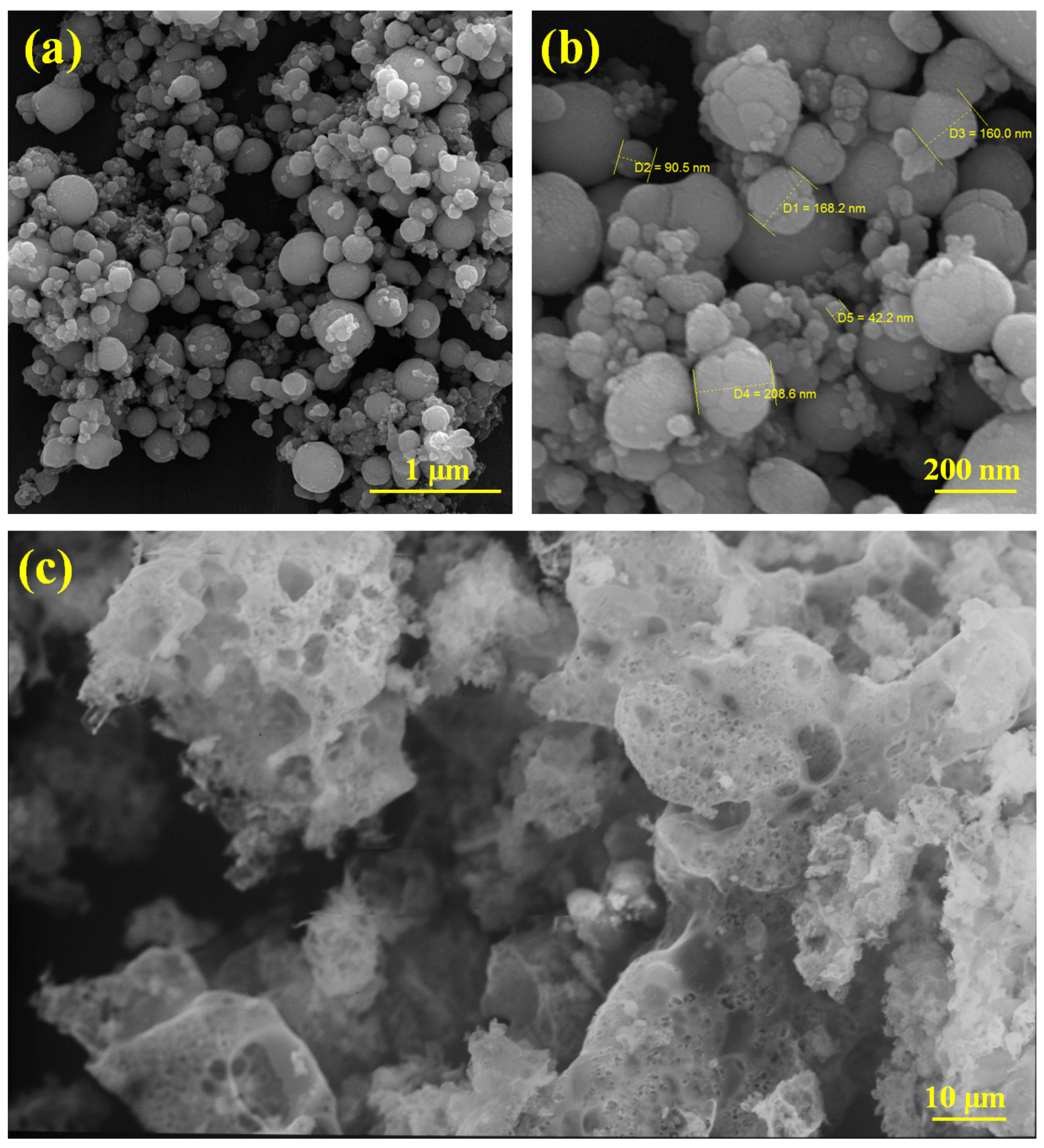
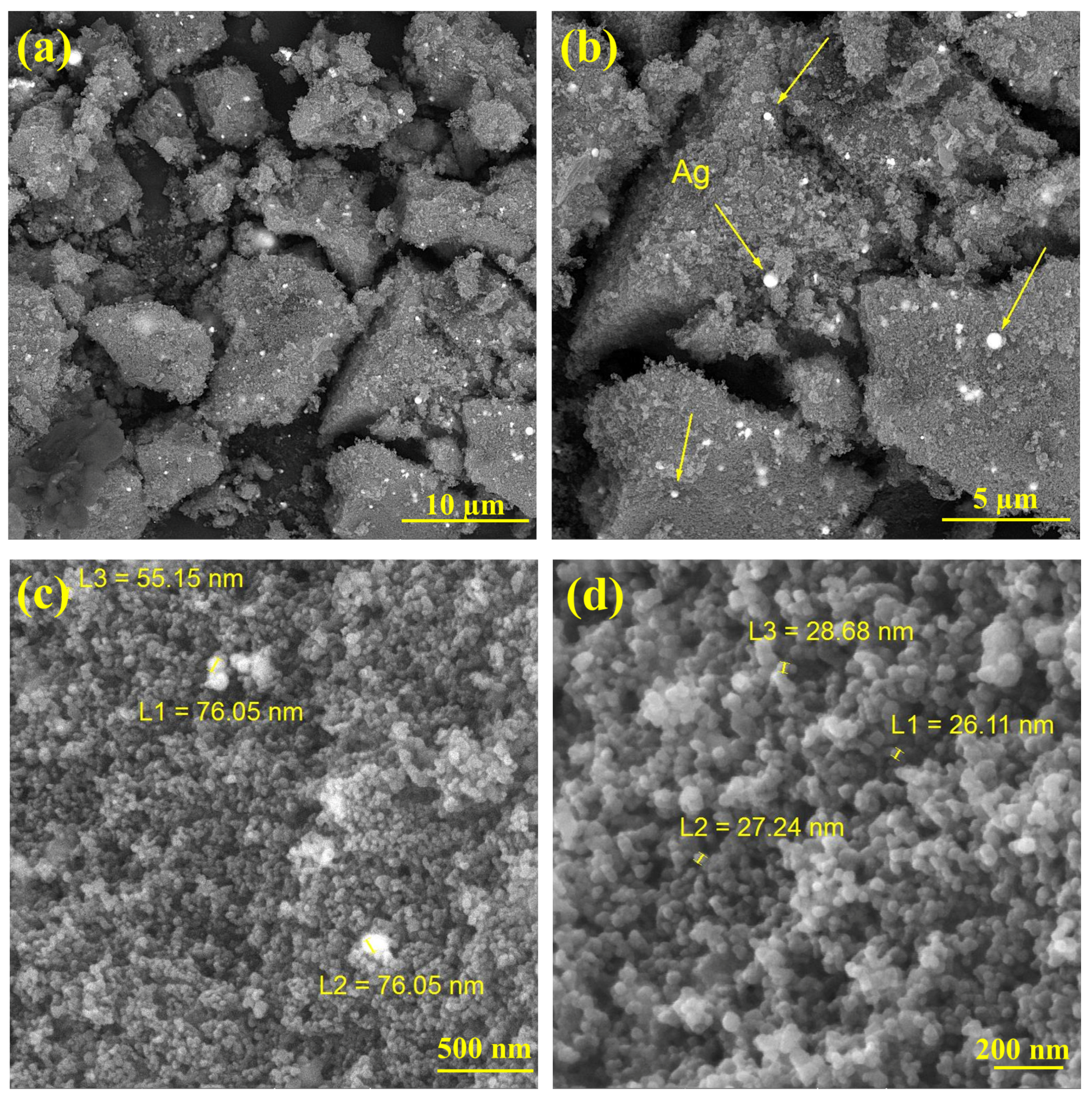
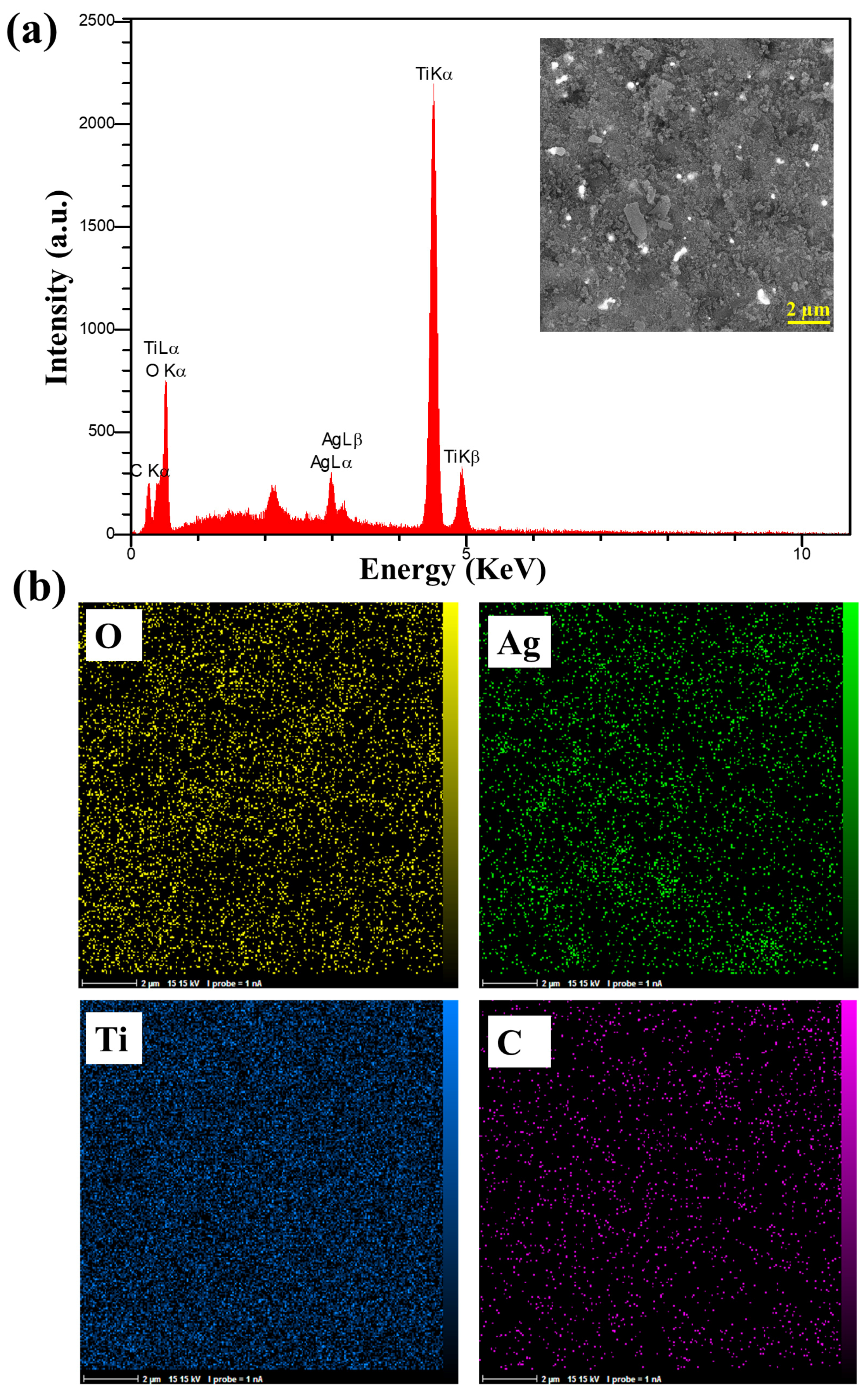
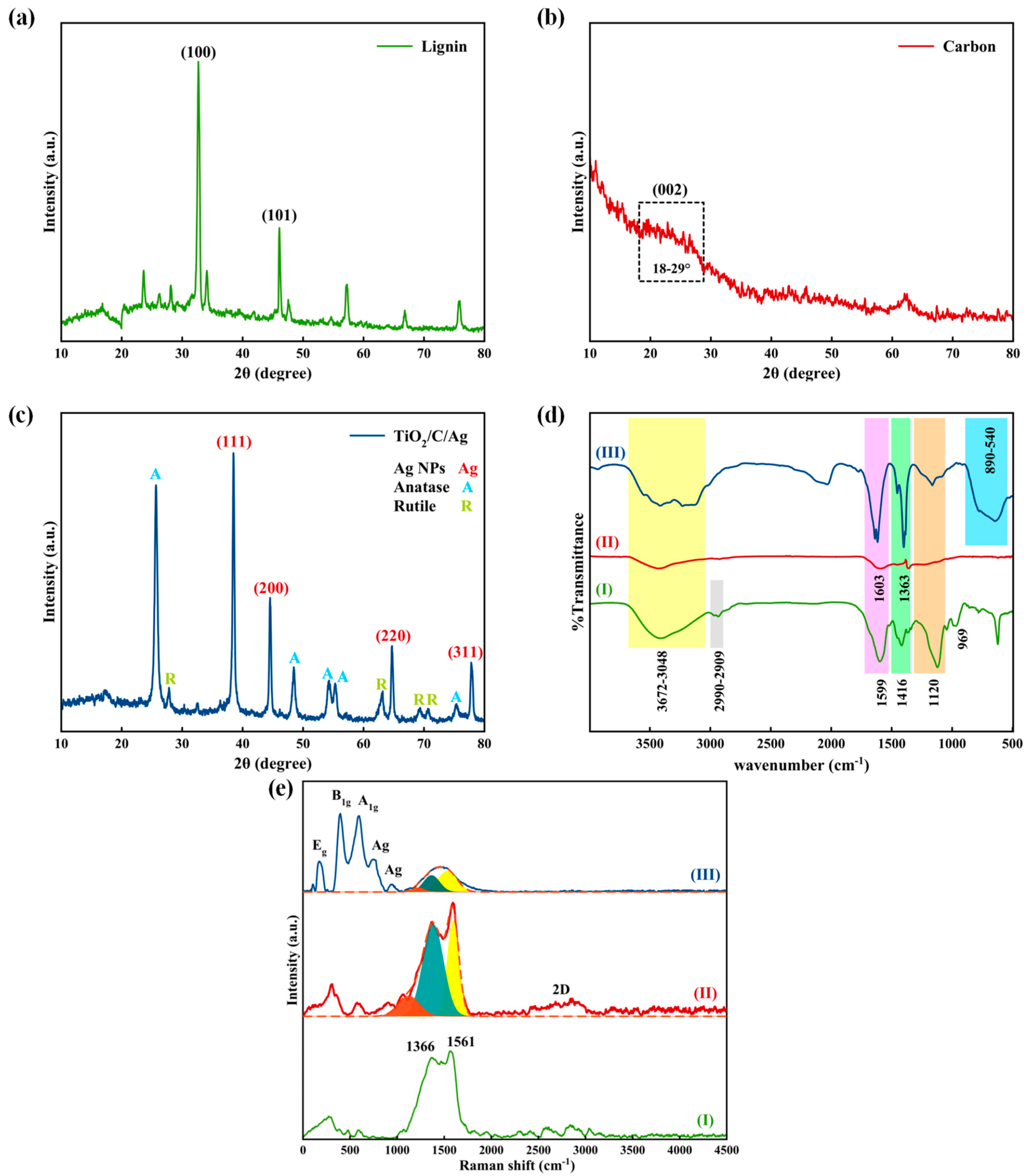
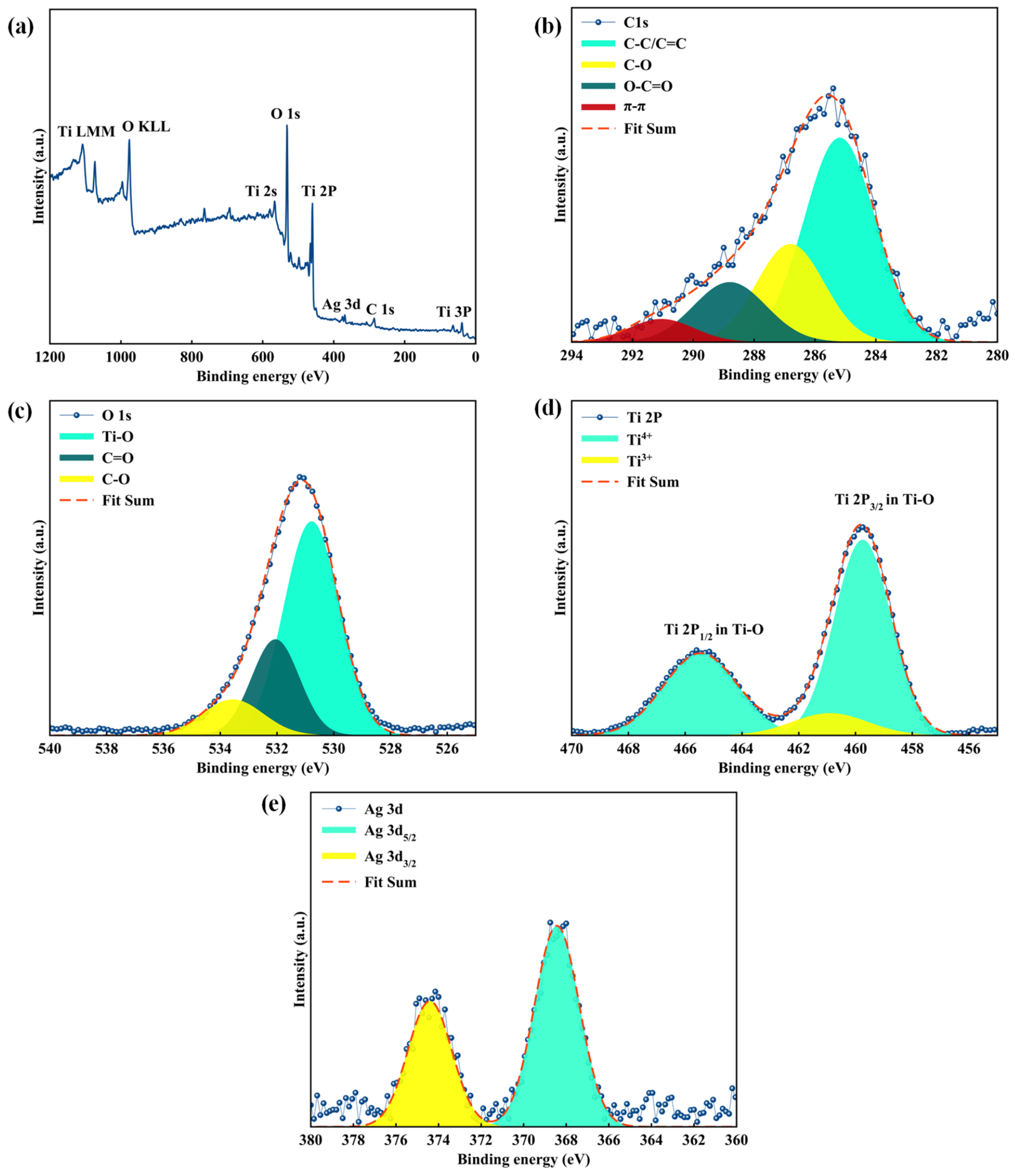
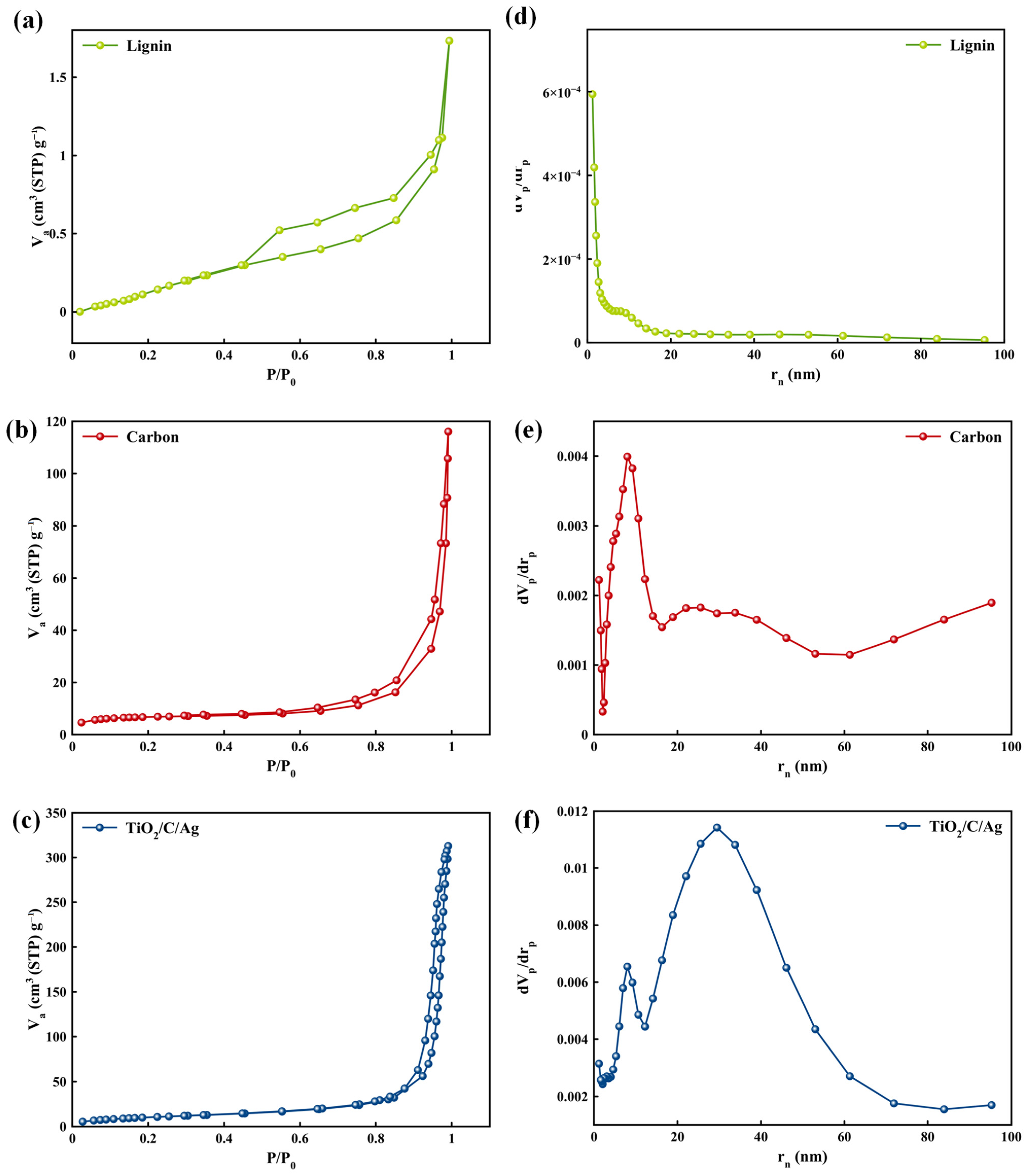

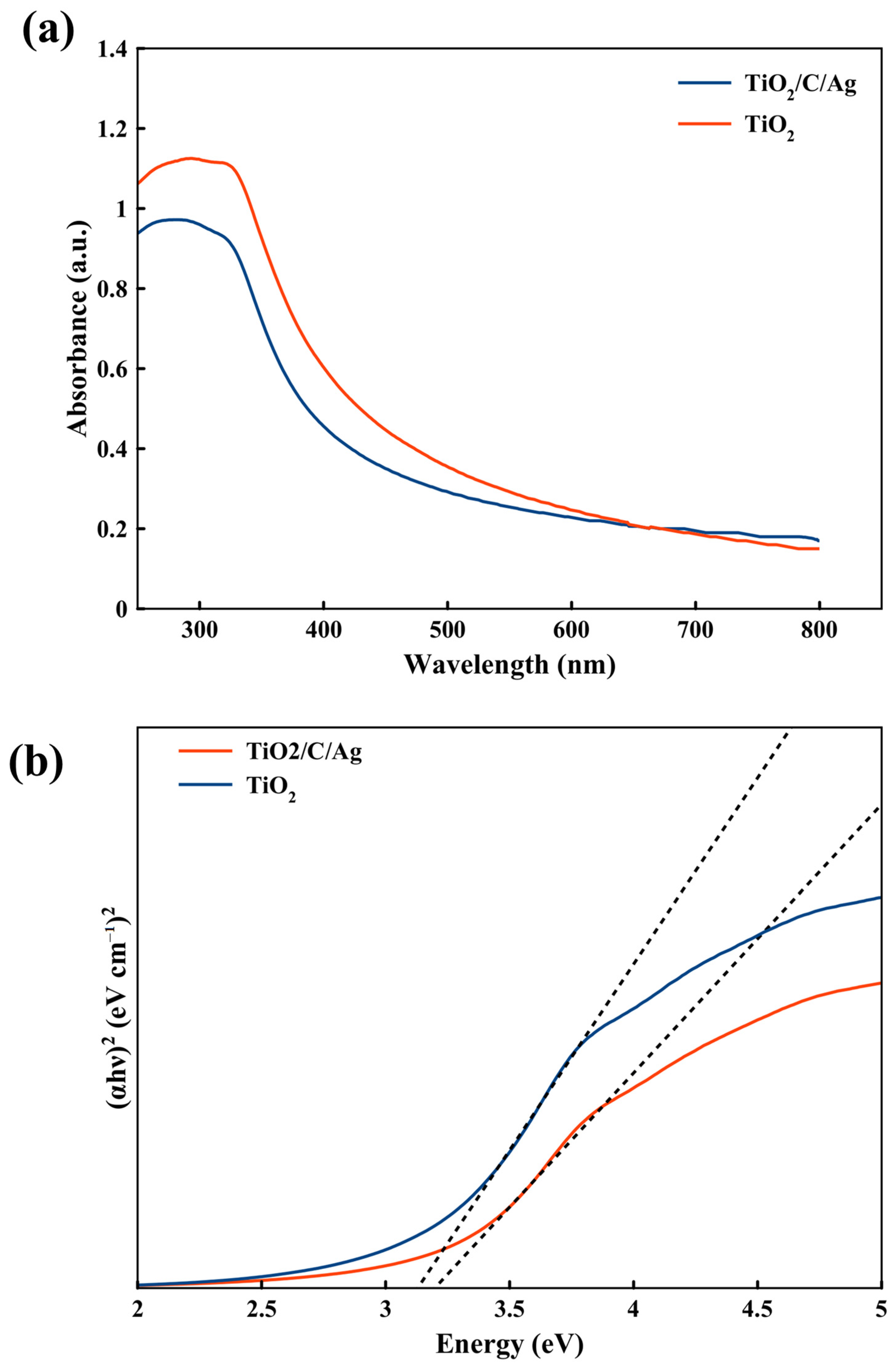
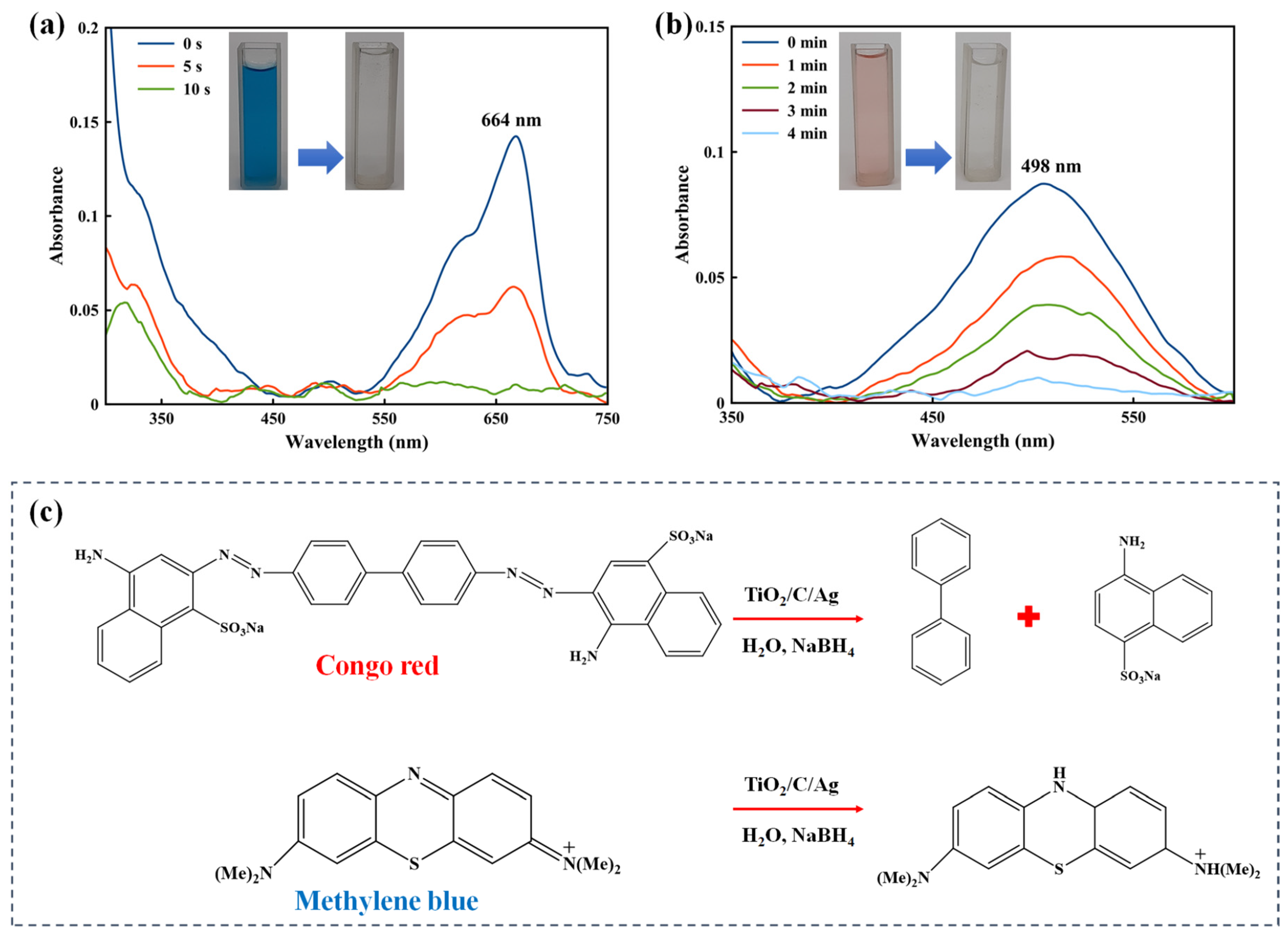


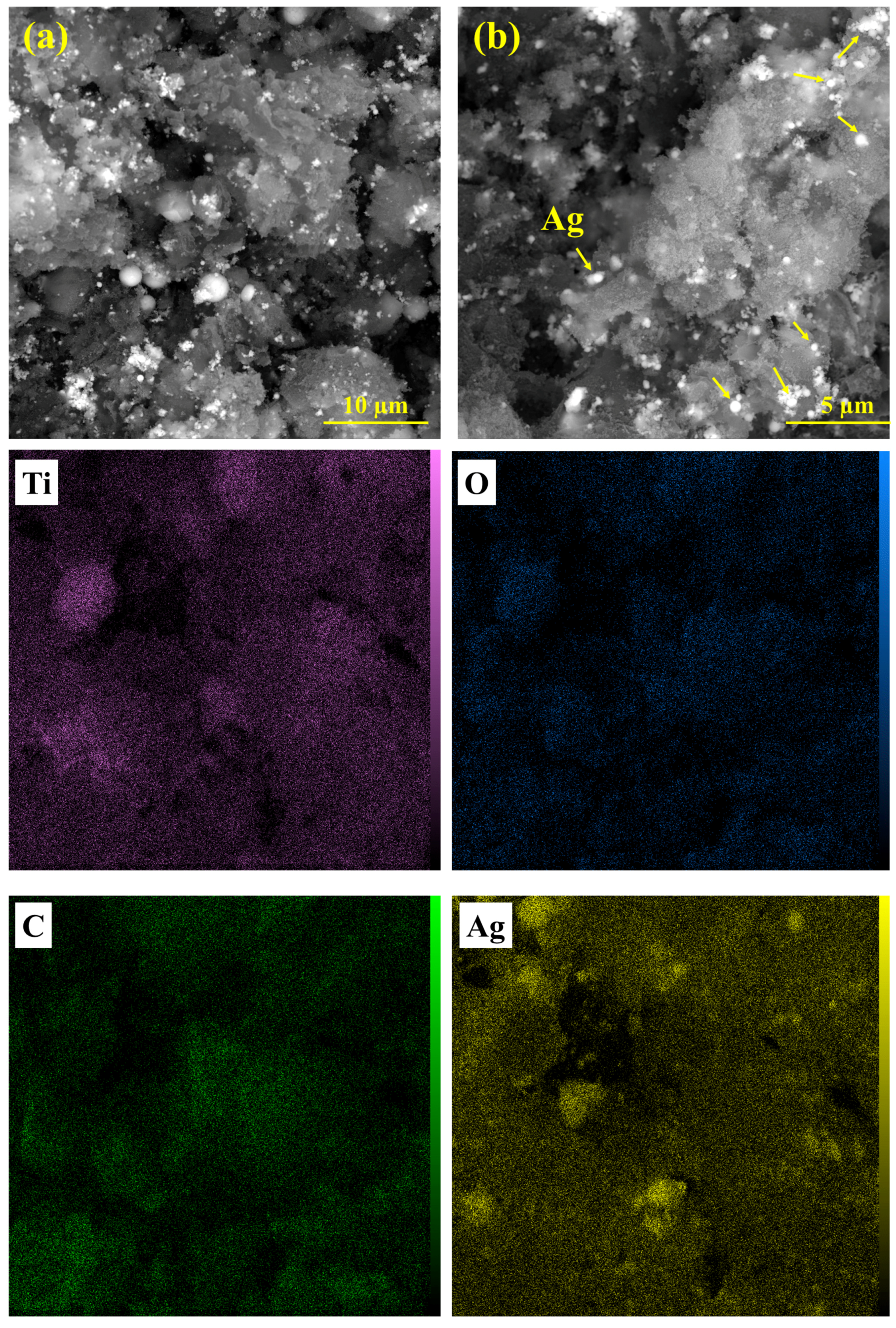
| Sample | Surface Area (m2/g) | Total Pore Volume (cm3/g) | Mean Pore Diameter (nm) |
|---|---|---|---|
| Lignin | 0.77 | 0.0025 | 12.9 |
| Carbon | 25.53 | 0.1671 | 26.2 |
| TiO2/C/Ag | 39.49 | 0.4751 | 48.1 |
| Pollutant | Catalyst | Concentration of Pollutant | Concentration of NaBH4 | Dye Removal Time | Ref. |
|---|---|---|---|---|---|
| MB | Ag NPs/silica spheres | 2 × 10−5 M | 1 × 10−2 M | 7.5 min | [78] |
| Ag NPs | 0.001 M | 0.1 M | 13 min | [79] | |
| Ag/GO | 0.030 mM | 500 mM | 7 min | [80] | |
| Ag/silicon zeolite nanoparticle | 0.06 mM | 60 mM | 4 min | [81] | |
| Ag/RGO | 30 mg/L | 0.1 M | 10 min | [82] | |
| TiO2/C/Ag | 3.1 × 10−5 M | 5.3 × 10−3 M | 10 s | This work | |
| CR | Ag NPs@hollow mesoporous carbon spheres | 0.086 mM | 0.5 M | 10 min | [83] |
| Ag NPs | 1 mM | 10 mM | 15 min | [84] | |
| AgNPs/holocellulose nanofibrils | 30 mg/L | 400 mg/L | 30 min | [85] | |
| TiO2/C/Ag | 1.44 × 10−5 M | 5.3 × 10−3 M | 4 min | This work |
| Pollutant | Catalyst | NaBH4 | Time |
|---|---|---|---|
| 4-NP | - | 250 mM | 120 min a |
| TiO2/C (8 mg) | 250 mM | 120 min a | |
| TiO2/C/Ag (8 mg) | 250 mM | 2.30 min | |
| CR | - | 5.3 mM | 35 min |
| TiO2/C (8 mg) | 5.3 mM | 20 min | |
| TiO2/C/Ag (8 mg) | 5.3 mM | 4 min | |
| MB | - | 5.3 mM | 2 min |
| TiO2/C (8 mg) | 5.3 mM | 1 min | |
| TiO2/C/Ag (8 mg) | 5.3 mM | 10 s |
Disclaimer/Publisher’s Note: The statements, opinions and data contained in all publications are solely those of the individual author(s) and contributor(s) and not of MDPI and/or the editor(s). MDPI and/or the editor(s) disclaim responsibility for any injury to people or property resulting from any ideas, methods, instructions or products referred to in the content. |
© 2024 by the authors. Licensee MDPI, Basel, Switzerland. This article is an open access article distributed under the terms and conditions of the Creative Commons Attribution (CC BY) license (https://creativecommons.org/licenses/by/4.0/).
Share and Cite
Almasi Nezhad, S.; Jaleh, B.; Darabi, E.; Dorranian, D. Laser-Assisted Preparation of TiO2/Carbon/Ag Nanocomposite for Degradation of Organic Pollutants. Materials 2024, 17, 4118. https://doi.org/10.3390/ma17164118
Almasi Nezhad S, Jaleh B, Darabi E, Dorranian D. Laser-Assisted Preparation of TiO2/Carbon/Ag Nanocomposite for Degradation of Organic Pollutants. Materials. 2024; 17(16):4118. https://doi.org/10.3390/ma17164118
Chicago/Turabian StyleAlmasi Nezhad, Shahin, Babak Jaleh, Elham Darabi, and Davoud Dorranian. 2024. "Laser-Assisted Preparation of TiO2/Carbon/Ag Nanocomposite for Degradation of Organic Pollutants" Materials 17, no. 16: 4118. https://doi.org/10.3390/ma17164118





